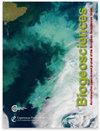加州圣巴巴拉盆地沉积物硫酸盐还原带中潜在甲烷循环和非产甲烷甲胺消耗的证据
IF 3.9
2区 地球科学
Q1 ECOLOGY
引用次数: 0
摘要
摘要最近在海洋和湿地沉积物硫酸盐还原带中发现的隐性甲烷循环将甲基营养化甲烷生成与甲烷厌氧氧化(AOM)结合在一起。在这里,我们提出的证据表明,在硫酸盐还原带的上部区域,沿着圣巴巴拉盆地的深度样带,美国加利福尼亚海岸附近,有潜在的甲烷循环活动。每个站点的沉积物顶部0-20 cm进行了地球化学分析,并使用35S-SO42 -, 14c -单甲胺和14C-CH4进行放射性示踪剂培养,以寻找潜在甲烷循环的证据。尽管AOM率随着水深的降低而增加(最深的站点最大值为0.05 nmol cm−3 d−1,最浅的站点最大值为1.8 nmol cm−3 d−1),但整个深度样带的甲烷浓度始终较低(3 ~ 16µM)。尽管在35S-SO42 -培养液中检测到硫酸盐还原活性,速率高达134 nmol cm−3 d−1,但孔隙水硫酸盐浓度仍然很高(23至29 mM)。代谢组学分析表明,孔隙水中产甲烷的底物(即醋酸酯、甲醇和甲胺)大多低于检测限,但一些1-2 cm深度剖面的样品显示出这些底物的不可量化证据,表明它们的快速周转。估计单甲胺产甲烷的范围为0.2至0.5 nmol cm - 3 d - 1。甲烷生成速率常数(k)(来自14c -单甲胺)和AOM(来自14c -单甲胺衍生的14C-CH4或直接注入的14C-CH4)之间的差异表明,一个单独的、同步的代谢过程的活性直接将单甲胺代谢成无机碳。我们得出的结论是,这项工作的结果显示了在圣巴巴拉盆地沉积物的顶部20厘米内发生潜在甲烷循环的有力证据。甲烷生成和甲烷向性之间的碳快速循环可能会阻止硫酸盐还原区甲烷的大量积聚。此外,我们的数据表明,甲胺被能够产甲烷的产甲烷古菌和非产甲烷的微生物群利用。我们假设硫酸盐还原是额外的甲胺周转的原因,但需要进一步的研究来阐明这种代谢活性。本文章由计算机程序翻译,如有差异,请以英文原文为准。
Evidence of cryptic methane cycling and non-methanogenic methylamine consumption in the sulfate-reducing zone of sediment in the Santa Barbara Basin, California
Abstract. The recently discovered cryptic methane cycle in the sulfate-reducing zone of marine and wetland sediment couples methylotrophic methanogenesis to anaerobic oxidation of methane (AOM). Here we present evidence of cryptic methane cycling activity within the upper regions of the sulfate-reducing zone, along a depth transect within the Santa Barbara Basin, off the coast of California, USA. The top 0–20 cm of sediment from each station was subjected to geochemical analyses and radiotracer incubations using 35S–SO42-, 14C–mono-methylamine, and 14C–CH4 to find evidence of cryptic methane cycling. Methane concentrations were consistently low (3 to 16 µM) across the depth transect, despite AOM rates increasing with decreasing water depth (from max 0.05 nmol cm−3 d−1 at the deepest station to max 1.8 nmol cm−3 d−1 at the shallowest station). Porewater sulfate concentrations remained high (23 to 29 mM), despite the detection of sulfate reduction activity from 35S–SO42- incubations with rates up to 134 nmol cm−3 d−1. Metabolomic analysis showed that substrates for methanogenesis (i.e., acetate, methanol and methylamines) were mostly below the detection limit in the porewater, but some samples from the 1–2 cm depth section showed non-quantifiable evidence of these substrates, indicating their rapid turnover. Estimated methanogenesis from mono-methylamine ranged from 0.2 to 0.5 nmol cm−3 d−1. Discrepancies between the rate constants (k) of methanogenesis (from 14C–mono-methylamine) and AOM (from either 14C–mono-methylamine-derived 14C–CH4 or from directly injected 14C–CH4) suggest the activity of a separate, concurrent metabolic process directly metabolizing mono-methylamine to inorganic carbon. We conclude that the results presented in this work show strong evidence of cryptic methane cycling occurring within the top 20 cm of sediment in the Santa Barbara Basin. The rapid cycling of carbon between methanogenesis and methanotropy likely prevents major build-up of methane in the sulfate-reducing zone. Furthermore, our data suggest that methylamine is utilized by both methanogenic archaea capable of methylotrophic methanogenesis and non-methanogenic microbial groups. We hypothesize that sulfate reduction is responsible for the additional methylamine turnover, but further investigation is needed to elucidate this metabolic activity.
求助全文
通过发布文献求助,成功后即可免费获取论文全文。
去求助
来源期刊

Biogeosciences
环境科学-地球科学综合
CiteScore
8.60
自引率
8.20%
发文量
258
审稿时长
4.2 months
期刊介绍:
Biogeosciences (BG) is an international scientific journal dedicated to the publication and discussion of research articles, short communications and review papers on all aspects of the interactions between the biological, chemical and physical processes in terrestrial or extraterrestrial life with the geosphere, hydrosphere and atmosphere. The objective of the journal is to cut across the boundaries of established sciences and achieve an interdisciplinary view of these interactions. Experimental, conceptual and modelling approaches are welcome.
 求助内容:
求助内容: 应助结果提醒方式:
应助结果提醒方式:


